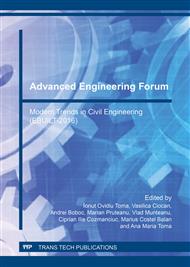p.175
p.183
p.190
p.196
p.207
p.213
p.219
p.226
p.234
Coatings Innovations on the Inner Shell of Metal Grain Silos
Abstract:
Some of the current research concerns the development of sustainability metallic silos study, highlights aspects of the treatment methods of the inner surface of the silos against the corrosive flow effects of granular material. By repeating the cycle of loading - unloading of granular material silo may lose bearing capacity due to the fatigue phenomenon. As a result, corrosion protection is required because of the silos can lead to a longer lifespan. Studies in this area aimed at finding new protection solutions, compatible with the granular material in store. In the field of metal silos, one of the innovative solutions, it consists of applying a protective coating on the inner wall layer made from ceramic powders and a composite material consisting of a resin reinforced with a specific curing agent. It is obtained such a protective steel with ceramic, applicable for walls silos, basic requirement consisting in achieve a interdiffusion physical, chemical or electrical between the two materials and the production of a minimum residual voltage at ceramic interface. The methodology for creating adhesion to metal-ceramic is described in this paper.
Info:
Periodical:
Pages:
207-212
Citation:
Online since:
March 2017
Authors:
Keywords:
Price:
Сopyright:
© 2017 Trans Tech Publications Ltd. All Rights Reserved
Share:
Citation:


